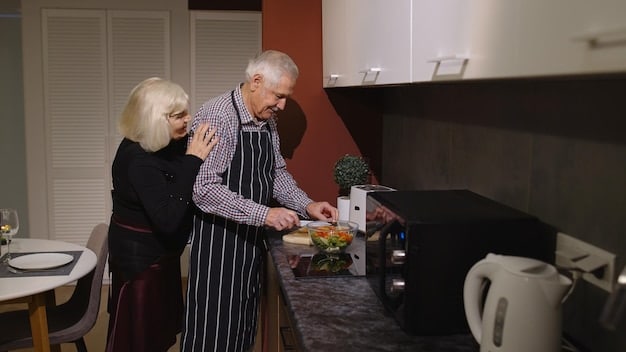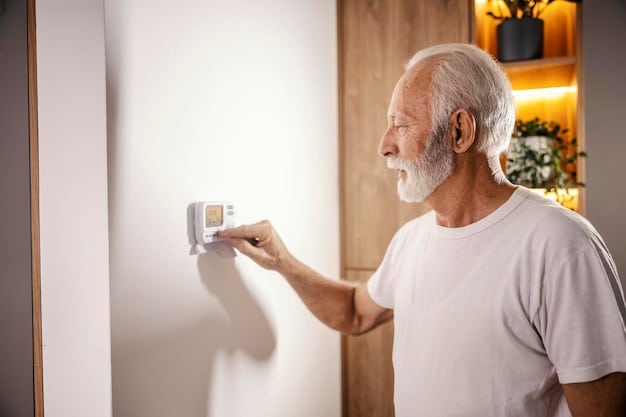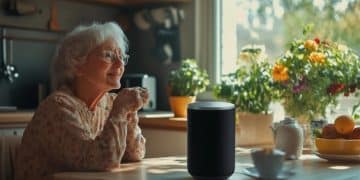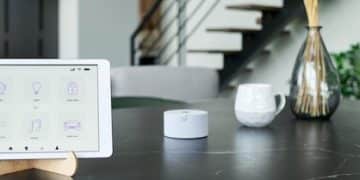Smart Home for Seniors: Tech for Enhanced Independence and Safety

Smart home technology for seniors enhances independence and safety through assistive devices, remote monitoring, and automated tasks, promoting a more comfortable and secure living environment.
Discover how smart home for seniors: enhance independence and safety with assistive technology can transform the lives of elderly individuals, providing them with greater autonomy and peace of mind. This technology includes a range of devices and systems designed to make daily tasks easier, improve safety, and enhance overall well-being.
Understanding the Benefits of Smart Home Technology for Seniors
Smart home technology offers numerous benefits for seniors, addressing key challenges related to aging in place. These technologies can help to improve safety, increase independence, and provide peace of mind for both seniors and their families.
By leveraging these advancements, seniors can maintain a higher quality of life and remain in their homes longer, surrounded by familiar comforts and memories.
Enhanced Safety and Security
One of the primary advantages of smart home technology is the ability to enhance safety and security for seniors. Devices such as smart doorbells, security cameras, and motion sensors can provide real-time monitoring and alerts, reducing the risk of accidents and break-ins.
Additionally, emergency response systems integrated into smart home setups can quickly summon help in the event of a fall or other medical emergency.
Increased Independence and Convenience
Smart home devices can also significantly increase independence and convenience for seniors. Voice-controlled assistants, smart lighting systems, and automated appliances make it easier to manage daily tasks without requiring assistance from others.
- Voice-activated controls: Allow seniors to manage lights, thermostats, and appliances using simple voice commands.
- Automated medication dispensers: Help seniors adhere to their medication schedules, reducing the risk of missed doses or overdoses.
- Smart kitchen appliances: Can assist with meal preparation and ensure that seniors have access to nutritious food.
Overall, these technologies empower seniors to maintain their independence and live more comfortably in their own homes.

Key Smart Home Devices for Senior Living
Selecting the right smart home devices is crucial for creating a safe and supportive environment for seniors. Several key devices can address specific needs and challenges related to aging in place.
These devices range from simple gadgets to comprehensive systems, offering a wide range of features and capabilities designed to improve the quality of life for seniors.
Smart Security Systems
Smart security systems are essential for protecting seniors from potential threats and accidents. These systems often include components such as door and window sensors, motion detectors, and security cameras, providing comprehensive monitoring and alerts.
Many smart security systems also offer professional monitoring services, which can provide an added layer of protection in the event of an emergency.
Voice-Activated Assistants
Voice-activated assistants such as Amazon Echo and Google Home can be incredibly helpful for seniors, allowing them to control various smart home devices using voice commands.
- Setting reminders: Voice assistants can help seniors remember important appointments and medication schedules.
- Making phone calls: Seniors can easily make phone calls to family members or emergency services using voice commands.
- Controlling entertainment: Voice assistants can play music, audiobooks, and podcasts, providing entertainment and mental stimulation.
- Answering questions: Seniors can ask voice assistants questions about news, weather, and other topics.
These devices can also be programmed to recognize emergency phrases and automatically call for help if needed.
Smart Lighting and Thermostats
Smart lighting and thermostat systems can help seniors maintain a comfortable and safe living environment. These systems can be programmed to automatically adjust lighting levels and temperature settings based on time of day or activity.
Smart lighting can also help prevent falls by providing adequate illumination in hallways and other areas where seniors are at risk of tripping.
Additionally, smart thermostats can help seniors save energy and reduce their utility bills by automatically adjusting temperature settings when they are away from home.
Implementing Smart Home Technology: A Step-by-Step Guide
Implementing smart home technology for seniors requires careful planning and execution. Following a step-by-step guide can help ensure a smooth and successful installation process.
This guide includes assessing the senior’s needs, selecting the appropriate devices, installing and configuring the technology, and providing ongoing support and training.
Assess the Senior’s Needs and Preferences
The first step in implementing smart home technology is to assess the senior’s needs and preferences. This involves identifying any challenges or limitations they may be facing and determining which smart home devices can best address these issues.
It is also important to consider the senior’s comfort level with technology and to involve them in the decision-making process as much as possible.
Select the Appropriate Devices
Once you have a clear understanding of the senior’s needs and preferences, you can begin selecting the appropriate smart home devices. Consider factors such as ease of use, reliability, and compatibility with other devices in the home.
- Read reviews: Research different brands and models to find devices that have positive reviews and a proven track record of performance.
- Consider compatibility: Ensure that all devices are compatible with each other and with the existing home infrastructure.
- Prioritize ease of use: Choose devices that are simple to set up and operate, with clear instructions and intuitive interfaces.
It may be helpful to consult with a smart home expert or installer to get recommendations and guidance on selecting the best devices for your specific needs.

Install and Configure the Technology
The next step is to install and configure the smart home technology. This may involve mounting devices, connecting them to the home network, and setting up user accounts and preferences.
It is important to follow the manufacturer’s instructions carefully and to test the devices thoroughly to ensure that they are working properly.
Addressing Common Concerns and Challenges
While smart home technology offers many benefits for seniors, it also presents some potential concerns and challenges. Addressing these issues proactively can help ensure a positive and successful implementation.
Common concerns include privacy and security, technology literacy, and the cost of devices and services. Overcoming these challenges requires careful planning, education, and support.
Privacy and Security
One of the biggest concerns related to smart home technology is privacy and security. Many smart home devices collect and transmit personal data, which could be vulnerable to hacking or unauthorized access.
To mitigate these risks, it is important to choose devices from reputable manufacturers that have strong security measures in place. You should also take steps to protect your home network by using strong passwords and enabling two-factor authentication.
Technology Literacy
Another challenge is technology literacy. Many seniors may be unfamiliar with smart home technology and may struggle to learn how to use it effectively. To address this issue, it is important to provide clear and patient training and support.
Consider offering hands-on demonstrations, written instructions, and ongoing assistance to help seniors become comfortable with their new devices.
Cost
The cost of smart home technology can also be a barrier for some seniors. Smart home devices and services can be expensive, especially for those on a fixed income.
To make smart home technology more accessible, consider starting with a few essential devices and gradually adding more over time. You may also be able to find discounts or financial assistance programs that can help offset the cost.
The Future of Smart Home Technology for Seniors
The field of smart home technology is constantly evolving, with new devices and features being developed all the time. The future of smart home technology holds great promise for seniors, with the potential to further enhance their independence, safety, and quality of life.
Emerging trends include advanced sensor technology, artificial intelligence, and personalized care solutions.
Advanced Sensor Technology
Advanced sensor technology is being developed to monitor seniors’ health and well-being in real time. These sensors can track vital signs, detect falls, and monitor activity levels, providing valuable insights into seniors’ overall health.
This information can be used to provide proactive care and support, helping seniors stay healthy and independent for longer.
Artificial Intelligence (AI)
Artificial intelligence is also playing an increasingly important role in smart home technology for seniors. AI-powered systems can learn seniors’ habits and preferences, automating tasks and providing personalized recommendations.
AI can also be used to detect abnormalities in seniors’ behavior, such as changes in sleep patterns or eating habits, and to alert caregivers or family members if there is a potential problem.
Personalized Care Solutions
The future of smart home technology for seniors also includes personalized care solutions. These solutions combine smart home devices with remote monitoring and support services to provide comprehensive care for seniors in their own homes.
Personalized care solutions can help seniors maintain their independence while also providing them with the peace of mind that they are being cared for and supported.
Resources and Support for Smart Home Implementation
Implementing smart home technology for seniors can be a complex undertaking. Fortunately, there are many resources and support services available to help seniors and their families navigate the process.
These resources include government programs, non-profit organizations, and professional installers and consultants.
Government Programs
Several government programs offer assistance with smart home technology for seniors. These programs may provide financial assistance, technical support, or educational resources.
Some examples of these programs include the Aging and Disability Resource Centers (ADRCs) and the Area Agencies on Aging (AAAs).
Non-Profit Organizations
Non-profit organizations also offer valuable resources and support for smart home implementation. These organizations may provide volunteer services, educational workshops, or advocacy efforts.
Examples of these organizations include the AARP and the National Council on Aging (NCOA).
Professional Installers and Consultants
Professional installers and consultants can provide expert guidance and support for smart home implementation. These professionals can help seniors and their families assess their needs, select the appropriate devices, install and configure the technology, and provide ongoing training and support.
It is important to choose installers and consultants who have experience working with seniors and who are knowledgeable about the latest smart home technologies.
| Key Point | Brief Description |
|---|---|
| 🛡️ Enhanced Safety | Smart security systems and emergency alerts ensure senior’s safety and fast assistance. |
| 💪 Increased Independence | Voice assistants and automated tasks allow seniors to live more independently. |
| 🏥 Health Monitoring | Advanced sensors track vital signs and detect falls for proactive healthcare. |
| 💡 Personalized Care | AI-powered solutions offer tailored support and automation for seniors’ needs. |
Frequently Asked Questions
▼
Key devices include smart security systems, voice-activated assistants, smart lighting, and thermostats, all designed to enhance safety and convenience.
▼
Smart security systems, fall detection sensors, and emergency alerts provide real-time monitoring and quick assistance in emergencies, improving safety.
▼
Yes, voice-activated assistants automate tasks, smart lighting prevents falls, and medication dispensers help seniors manage their health independently.
▼
Data collection and potential hacking are concerns. Choosing reputable brands with robust security measures and securing your home network is crucial.
▼
Assess the senior’s needs, select user-friendly devices, start with essential features, and seek professional installation and training to ensure comfort and safety.
Conclusion
Smart home for seniors: enhance independence and safety with assistive technology has emerged as a transformative solution, offering elderly individuals greater autonomy, improved safety, and enhanced overall well-being. By carefully selecting and implementing the right devices, addressing potential concerns, and leveraging available resources, families can create a supportive and empowering environment that enables seniors to age in place with dignity and peace of mind.





